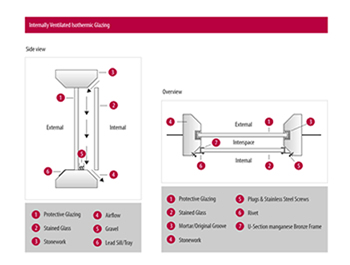Protection

Isothermal Glazing
This method of environmental protection is used throughout Britain and Europe to deter further corrosion of the glass as much as possible. The protective glazing system keeps the glass dry on both sides by retaining the air at a similar temperature all the way round the glass, therefore stopping condensation occurring on the painted surface of the glass. In the past much of the painted areas have been destroyed and lost forever due to the weathering. It is imperative that we try to prevent paint and glass damage of this nature happening to the glass we have left in buildings today, to preserve them for the future.How the Isothermal Glazing system works
The original glass is fixed in to a u-section manganese bronze frame. The heads and tracery are fixed into appropriately bent frames. The bronze is bent very easily to accommodate virtually any shape. Bars are soldered onto the frames if necessary and the panels are attached to the frames with ties. Leaf lead is soldered onto the frame to prevent light from entering the church at the sides, the flange is adjusted to allow for ventilation. The frames are brought forward into the church and fixed to the stonework with plugs and stainless steel screws.Panels re-fixed into the original groove using the main lead line shapes of the original glass design. Using kiln formed sheet glass, deters reflection on the outside and is more complimentary to the building.
Click here for full screen version of technical drawing below

We're here to help
Call us on:
01923 266386
Where one of us will be happy to help you with any query you may have.